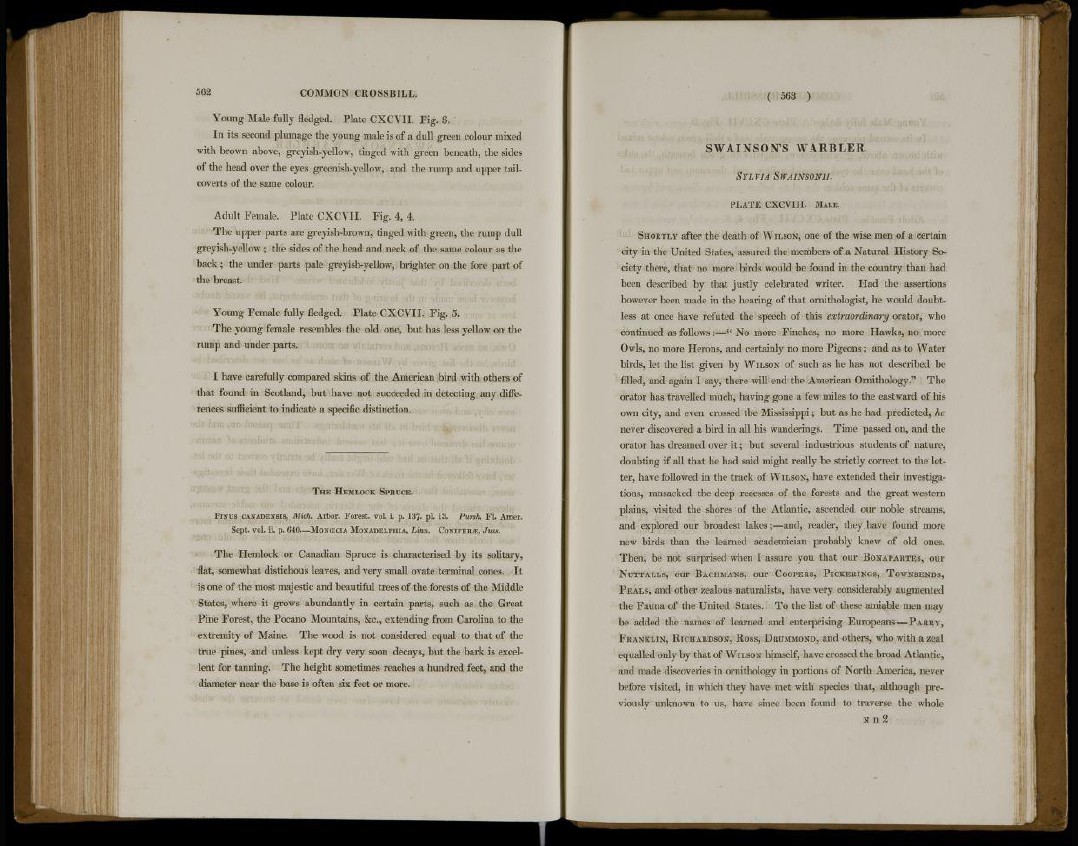
562 C O M M O N C R O S S B I L L .
Young Male fully fledged. Plate CXCVII. Fig. 3 .
In its second plumage the young male is of a dull green colour mixed
with brown above, greyish-yellow, tinged with green beneath, the sides
of the head over the eyes greenish-yellow, and the rump and upper tailcoverts
of the same colour.
Adult Female. Plate CXCVII. Fig. 4, 4.
The upper parts are greyish-brown, tinged with green, the rump dull
greyish-yellow; the sides of the head and neck of the same colour as the
back; the under parts pale greyish-yellow, brighter on the fore part of
the breast.
Young Female fully fledged. Plate CXCVII. Fig. 5.
The young female resembles the old one, but has less yellow on the
rump and under parts.
I have carefully compared skins of the American bird with others of
that found in Scotland, but have not succeeded in detecting any differences
sufficient to indicate a specific distinction.
THE HEMLOCK SPRUCE.
PINUS CANADENSIS, Mich. Arbor. Forest, vol. i. p. 137. pi. 13. Pursh. Fl. Amer.
Sept. vol. ii. p. 640—MONOSCIA MONADELPHIA, Linn. CONIFERS, Jim.
The Hemlock or Canadian Spruce is characterised by its solitary,
flat, somewhat distichous leaves, and very small ovate terminal cones. It
is one of the most majestic and beautiful trees of the forests of the Middle
States, where it grows abundantly in certain parts, such as the Great
Pine Forest, the Pocano Mountains, &c, extending from Carolina to the
extremity of Maine. The wood is not considered equal to that of the
true pines, and unless kept dry very soon decays, but the bark is excellent
for tanning. The height sometimes reaches a hundred feet, and the
diameter near the base is often six feet or more.
( 563 )
S W A I N S O N S WARBLER.
SYLVIA SWAINSONII.
P L A T E C X C V I I I . MALE.
SHORTLY after the death of WILSON, one of the wise men of a certain
city in the United States, assured the members of a Natural History Society
there, that no more birds would be found in the country than had
been described by that justly celebrated writer. Had the assertions
however been made in the hearing of that ornithologist, he would doubtless
at once have refuted the speech of this extraordinary orator, who
continued as follows:—" No more Finches, no more Hawks, no more
Owls, no more Herons, and certainly no more Pigeons; and as to Water
birds, let the list given by WILSON of such as he has not described be
filled, and again I say, there will end the American O r n i t h o l o g y T h e
orator has travelled much, having gone a few miles to the eastward of his
own city, and even crossed tbe Mississippi; but as he had predicted, he
never discovered a bird in all his wanderings. Time passed on, and the
orator has dreamed over i t ; but several industrious students of nature,
doubting if all that he had said might really be strictly correct to the letter,
have followed in the track of WILSON, have extended their investigations,
ransacked the deep recesses of the forests and the great western
plains, visited the shores of the Atlantic, ascended our noble streams,
and explored our broadest lakes;—and, reader, they have found more
new birds than the learned academician probably knew of old ones.
Then, be not surprised when I assure you that our BONAPARTES, our
NUTTALLS, our BACHMANS, our COOPERS, PICKERINGS, TOWNSENDS,
PEALS, and other zealous naturalists, have very considerably augmented
the Fauna of the United States. To the list of these amiable men may
be added the names of learned and enterprising Europeans—PARRY,
FRANKLIN, RICHARDSON, ROSS, DKUMMOND, and others, who with a zeal
equalled only by that of WILSON himself, have crossed the broad Atlantic,
and made discoveries in ornithology in portions of North America, never
before visited, in which they have met with species that, although previously
unknown to us, have since been found to traverse the whole
N n 2